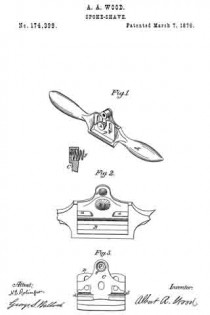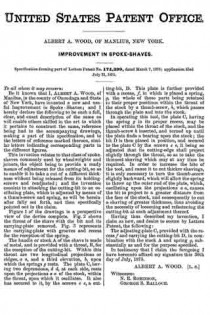No. 174,399 – Improvement In Spoke-Shaves (Albert A. Wood) (1876)

UNITED STATES PATENT OFFICE.
_________________
ALBERT A. WOOD, OF MANLIUS, NEW YORK.
IMPROVEMENT IN SPOKE-SHAVES.
_________________
Specification forming part of Letters Patent No. 174,399, dated March 7, 1876; application filed July 31, 1875.
_________________
To all whom it may concern:
Be it known that I, ALBERT A. WOOD, of Manlius, in the county of Onondaga and State of New York, have invented a new and useful Improvement in Spoke-Shaves; and I hereby declare the following to be such a full, clear, and exact description of the same as will enable others skilled in the art to which it pertains to construct the same, reference being had to the accompanying drawings, making a part of this specification, and to the letters of reference marked thereon, similar letters indicating corresponding parts in the different figures.
This invention relates to that class of spoke-shaves commonly used by wheelwrights and joiners, the object being to provide a ready means of adjustment for the cutting-bit, so as to enable it to take a cut of a different thickness without being released from its holding-screws and readjusted; and the invention consists in attaching the cutting-bit to an oscillating plate, which is adjusted by means of a thumb-screw and spring, as will be hereinafter fully set forth, and then specifically pointed out in the claim.
Figure 1 of the drawings is a perspective view of the device complete. Fig. 2 shows the throat of the shave with the bit and its carrying-plate removed. Fig. 3 represents the carrying-plate with grooves and recess for the reception of the spring.
The handle or stock A of the shave is made of metal, and is provided with a throat, B, for the reception of the cutting-bit. Within this throat are two longitudinal projections or ridges, a a, and a third elevation, b, upon which the springs g rests. The plate C, having two depressions, d d, at each side, rests upon the projections a a of the stock, within the throat, upon which it oscillates. It also has secured to it, by the screws e e, a cutting-bit, D. This plate is further provided with a recess, f in which is placed a spring, g, the whole of these parts being retained in their proper positions within the throat of the stock by a thumb-screw, h, which passes through the plate and into the stock.
In operating this tool, the plate C, having the spring g in its proper recess, may be placed within the throat of the stock, and the thumb-screw h inserted, and turned up until the plate finds a bearing upon the stock; the bit D is then placed in position, and secured to the plate G by the screws e e, it being so adjusted that its cutting-edge shall project slightly through the throat, so as to take the thinnest shaving which may at any time be required. In order to increase the bite of the tool, and cause it to cut thicker shavings, it is only necessary to turn the thumb-screw slightly backward, which will allow the spring to throw up the outer end of the plate, which, oscillating upon the projections a a, causes the bit to project to a greater distance from the face of the stock, and consequently to cut a shaving of greater thickness, thus avoiding the necessity of loosening and refastening the cutting-bit at each adjustment thereof.
Having thus described my invention, I claim as new, and desire to secure by Letters Patent, the following:
The adjusting-plate C, provided with the recess f and carrying the cutting-bit D, in combination with the stock A and spring g, substantially as and for the purpose specified.
In testimony that I claim the foregoing I have hereunto affixed my signature this 30th day of July, 1875.
ALBERT A. WOOD. [L. S.]
Witnesses:
N. E. ROBINSON,
GEORGE S. BALLOCH.


